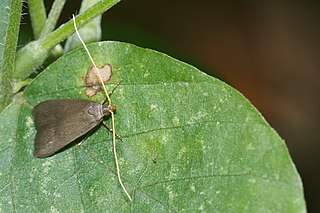
Corona Australis is a constellation in the Southern Celestial Hemisphere. Its Latin name means "southern crown", and it is the southern counterpart of Corona Borealis, the northern crown. It is one of the 48 constellations listed by the 2nd-century astronomer Ptolemy, and it remains one of the 88 modern constellations. The Ancient Greeks saw Corona Australis as a wreath rather than a crown and associated it with Sagittarius or Centaurus. Other cultures have likened the pattern to a turtle, ostrich nest, a tent, or even a hut belonging to a rock hyrax.

Triangulum Australe is a small constellation in the far Southern Celestial Hemisphere. Its name is Latin for "the southern triangle", which distinguishes it from Triangulum in the northern sky and is derived from the acute, almost equilateral pattern of its three brightest stars. It was first depicted on a celestial globe as Triangulus Antarcticus by Petrus Plancius in 1589, and later with more accuracy and its current name by Johann Bayer in his 1603 Uranometria. The French explorer and astronomer Nicolas Louis de Lacaille charted and gave the brighter stars their Bayer designations in 1756.

The plains rat(Pseudomys australis), also known as the palyoora, plains mouse and eastern mouse, is a conilurine rodent native to arid and semi-arid Australia. Referred to as the pallyoora or yarlie by Indigenous groups, the plains rat was once widely distributed across central Australia, including north-west New South Wales and south-west Queensland; however, habitat degradation due to grazing, introduced predators and drought have contributed to its decline. Consequently, the plains rat has been listed as 'presumed extinct' in New South Wales and Victoria, 'endangered' in the Northern Territory and Queensland and 'vulnerable' in Western Australia and South Australia. While recent research has indicated the presence of the plains rat in areas such as the Fowlers Gap and Strzelecki Desert regions of New South Wales and within the Diamantina National Park in Queensland, there are only five sub-populations currently recognised nationally, none of which coincide with recent discoveries of the plains rat. As the current population trend of the plains rat has been listed as 'declining' by the International Union for the Conservation of Nature (IUCN), the IUCN conservation status for the species is 'vulnerable'.

The Lecithocerinae are a subfamily of small moths in the family Lecithoceridae. They are found worldwide, but most species occur in South Asia. The subfamily is characterized by the male genitalia with a bridge-like structure connecting the tegumen and the valva, and the uncus almost always is vestigial with two lobes at the dorsal base, only exceptionally united into a broad plate, but never as a thorn or spine.

Homaloxestis is a genus of moths in the family Lecithoceridae. The genus was erected by Edward Meyrick in 1910.
Ulmus glabra 'Australis' is a Wych Elm cultivar described by Loudon in 1838, from a tree in the Royal Horticultural Society garden, as U. montana var. australisHort..

Amanita australis is a species of fungus in the family Amanitaceae. It is found only in New Zealand, where it occurs in Leptospermum and Nothofagus forest. The species was first described by New Zealand mycologist Greta Stevenson in 1962; in the same publication Stevenson also described what she thought was a unique species, Limacella macrospora, but over 30 years later this was reduced to synonymy with A. australis.
Homaloxestis baibaraensis is a moth in the family Lecithoceridae first described by Kyu-Tek Park in 1999. It is found in Taiwan.

Joshua Ryne Goldberg is an American internet troll, convicted of attempting a bombing on the 14th anniversary of the September 11 attacks while posing as an Islamic terrorist affiliated with ISIS.
Homaloxestis furcula is a moth in the family Lecithoceridae. It was described by Kyu-Tek Park in 2004. It is found in Thailand.
Homaloxestis multidentalis is a moth in the family Lecithoceridae. It was described by Kyu-Tek Park in 2004. It is found in Thailand.
Homaloxestis pumilis is a moth in the family Lecithoceridae. It was described by Kyu-Tek Park in 2004. It is found in Thailand.
Homaloxestis saitoi is a moth in the family Lecithoceridae. It was described by Kyu-Tek Park in 2004. It is found in Thailand.
Homaloxestis vinhphuensis is a moth in the family Lecithoceridae. It was described by Kyu-Tek Park in 2007. It is found in northern Vietnam.
Homaloxestis grabia is a moth in the family Lecithoceridae. It was described by Chun-Sheng Wu and Kyu-Tek Park in 1999. It is found in Sri Lanka.
Homaloxestis lacerta is a moth in the family Lecithoceridae. It was described by Chun-Sheng Wu and Kyu-Tek Park in 1999. It is found in Sri Lanka.
Homaloxestis plocamandra is a moth in the family Lecithoceridae. It was described by Edward Meyrick in 1907. It is found in Nepal, India, Bhutan, northern Vietnam, Thailand and the Philippines (Luzon).
Homaloxestis aganacma is a moth in the family Lecithoceridae. It was described by Alexey Diakonoff in 1968. It is found on Luzon in the Philippines.
Homaloxestis luzonensis is a moth in the family Lecithoceridae. It was described by Kyu-Tek Park and Bong-Kyu Byun in 2007. It is found on Luzon in the Philippines.
Homaloxestis quadralis is a moth in the family Lecithoceridae. It was described by Kyu-Tek Park and Bong-Kyu Byun in 2007. It is found in Palawan in the Philippines.






